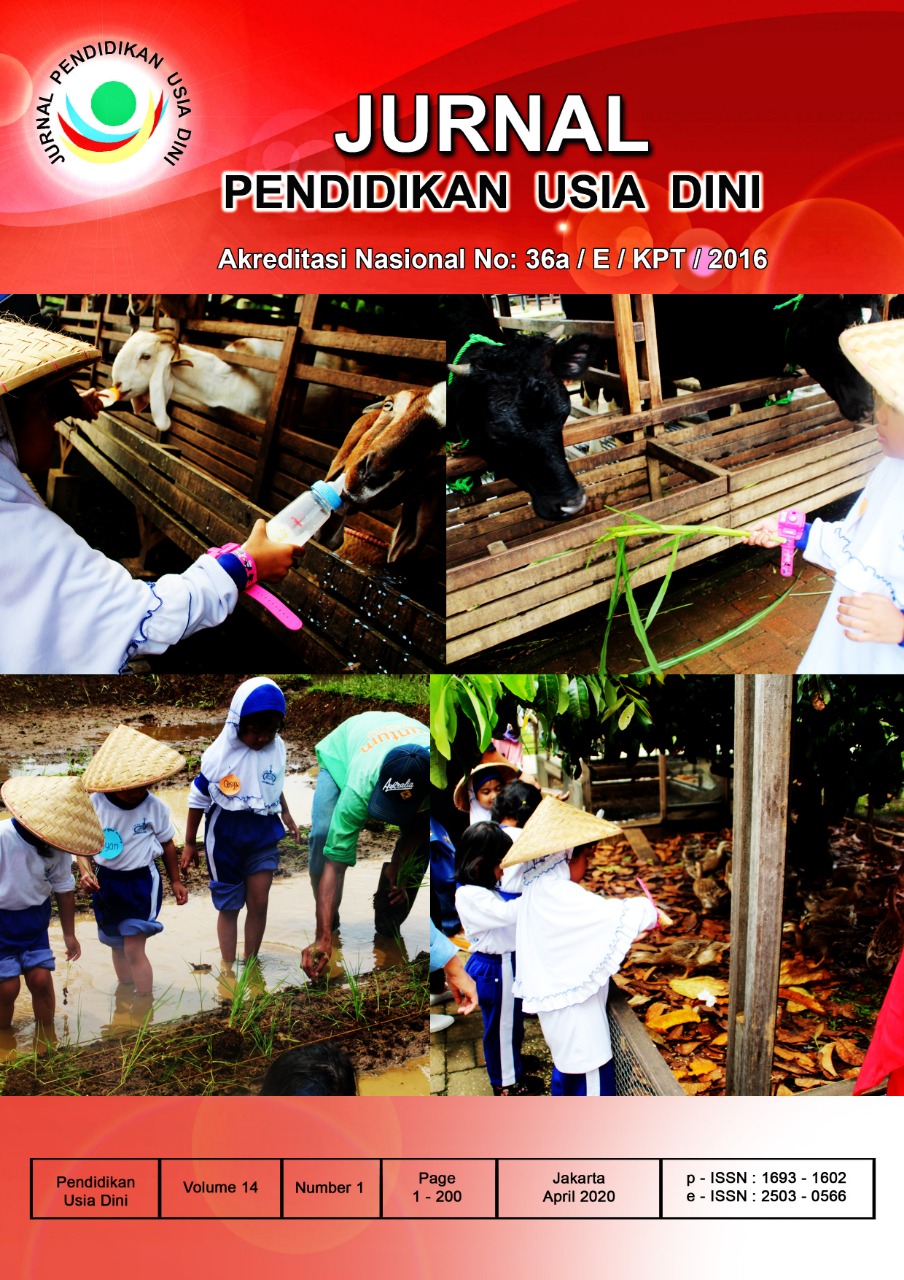The Cognitive Style and Attachment on Early Childhood Speech Skills
DOI:
https://doi.org/10.21009/JPUD.141.03Abstract
Concurrently with the rapid development in digital society, the demand for communication skills was clear in childhood. Early childhood education needs to pay attention to children's speech skills development. This study aims to determine the effect of cognitive style and attachment on the ability to speak in early childhood speech development. The method used is a 2 x 2 factorial comparison design which is divided into two groups namely independent and dependent fields involving 138 samples. Re- search findings about differences in the ability to speak early childhood who have independent field cognitive style and children who have field dependent cognitive style in groups of children with high attachment obtained (A2B1), obtained Q count = 9.39 and Q table (0.05; 4: 10) = 4 , 33. 4). Differences in the ability to speak early childhood who have an independent field cognitive style and children who have a field dependent cognitive style in groups of children with low attachment obtained (A2B2), ob- tained Q count = 4.39 and Q table (0.05; 4: 10) = 4 , 33. It show that early children who have independent field cognitive style have higher speech skills scores than early children who have field dependent cog- nitive style while early children who are independent field cognitive style with low attachment have lower speech skills scores than early childhood the field dependent cognitive style with low attachment.
Keywords: Cognitive style and Attachment, Early Childhood, Speech Skills
Reference
Aulya Purnama, R., & Wahyuni, S. (2018). Kelekatan (Attachment) pada Ibu dan Ayah Dengan Kompetensi Sosial pada Remaja. Jurnal Psikologi, 13(1), 30. https://doi.org/10.24014/jp.v13i1.2762
Berk, L. E. (2007). Child Development Boston. Pearson (seventh Ed). Boston: Pearson.
Borich, G. D., & Tombari., M. L. (1996). Educational Psychology: A Contemporary Approach.
New York: Harper Collins College Publishers.
Boroujerdi, F. G., Kimiaee, S. A., Yazdi, S. A. A., & Safa, M. (2019). Attachment style and history of childhood abuse in suicide attempters. Psychiatry Research, 271, 1–7. https://doi.org/10.1016/j.psychres.2018.11.006
Braune, R., & Wickens, C. D. (1986). Time-sharing revisited: Test of a componential model for the assessment of individual differences. Ergonomics, 29(11), 1399–1414. https://doi.org/10.1080/00140138608967254
Brodin, J., & Renblad, K. (2019). Improvement of preschool children’s speech and language skills. Early Child Development and Care, 0(0), 1–9. https://doi.org/10.1080/03004430.2018.1564917
Davis, D. (2011). Child Development, Third Edition: A Practitioner’s Guide (Clinical Practice with Children, Adolescents, and Families) (Third Edit). New York London: The Guilford Press.
Desmita. (2010). Psikologi Perkembangan Peserta Didik. Bandung: Rosdakarya.
Ding, Y. hua, Xu, X., Wang, Z. yan, Li, H. rong, & Wang, W. ping. (2014). The relation of infant attachment to attachment and cognitive and behavioural outcomes in early childhood. Early Human Development, 90(9), 459–464. https://doi.org/10.1016/j.earlhumdev.2014.06.004
Evans, R., & Jones, D. (2007). Perspectives on oracy-towards a theory of practice. Early Child Development and Care, 177(6–7), 557–567. https://doi.org/10.1080/03004430701424938
Feeney, J. A. (2001). Becoming Parents: Exploring The Bonds Between Mothers, Fathers, And Their Infants Paperback. UK: Cambridge University Press.
Gandasetiawan, R. Z. (2009). Mengoptimalkan IQ dan EQ Anak Melalui Metode Sensomotorik. Jakarta: PT BPK Gunung Mulia.
Goodman, M. L., Gibson, D., Vo, T. T., Wang, A., Gitari, S., & Raimer, B. (2018). Early childhood attachment and suicidal ideation among young Kenyan men. Advances in Life Course Research, 35(February), 126–134. https://doi.org/10.1016/j.alcr.2018.02.001
Holmes, J. (2014). John Bowlby and Attachment Theory (2nd Editio). https://doi.org/https://doi.org/10.4324/9781315879772
Kerlinger, F. N. (1990). Asas-asas Penelitian Behavioral (3th ed.). Yogyakarta: Gajah Mada University Press.
Larasati, N. I., & Desiningrum, dinie R. (2017). Hubungan Antara Kelekatan Aman Dengan Ibu Dan Regulasi Emosi Siswa Kelas X Sma Negeri 3 Salatiga. Empati, 6(3), 127–133.
Lwin, M., Khoo, A., Lyen, K., & Sim, C. (2002). How to Multiply Your Child’s Intelligence: A Practical Guide for Parents of Seven-Year-Olds and Below. Singapore: Pearson Education Asia Pte., Ltd.
Machado, J. M. (2012). Early Childhood Experiences in Language Arts: Early Literacy (10 edition). Belmont, USA: Wadsworth Publishing.
Madyawati, L. (2016). Strategi Pengembangan Bahasa Pada Anak. Jakarta: Kencana.
Mahabbati, A. (2013). Layanan Pendidikan untuk Anak Berkebutuhan Khusus dan Pendidikan Inklusif. Retrieved from http://staffnew.uny.ac.id/upload/132318126/pengabdian/ppmlayanan-pendidikan-untuk- anak-berkebutuhan-khusus.
McLeod, S., Harrison, L. J., & Wang, C. (2019). A longitudinal population study of literacy and numeracy outcomes for children identified with speech, language, and communication needs in early childhood. Early Childhood Research Quarterly, 47, 507–517. https://doi.org/10.1016/j.ecresq.2018.07.004
Nasution, S. (2011). Berbagai Pendekatan Dalam Proses Belajar Dan Mengajar. Jakarta: Bumi Aksara.
Nussipzhanova, B., Berdibayeva, S., Garber, A., Tuyakova, U., Mursaliyeva, A., & Baizhumanova, B. (2017). Cognitive development of pre-school children with language and speech disorders. The European Journal of Social and Behavioural Sciences, 21(1), 2570– 2583. https://doi.org/10.15405/ejsbs.227
Ormrod, J. E. (2009). Psikologi Pendidikan Membantu Siswa Tumbuh dan Berkembang (6th editio). Jakarta: Erlangga.
Otto, B. (2015). Perkembangan Bahasa Pada Anak Usia DIni (third Edit). Jakarta: Prenadamedia.
Papalia, D. (2008). Human Development. Jakarta: Kencana.
Platokhina, N. A., Samarina, I. V., & Abashina, N. N. (2016). Preventive Measures against Speech Disorders in Early Childhood. Procedia - Social and Behavioral Sciences, 233(May), 247–251. https://doi.org/10.1016/j.sbspro.2016.10.212
Pudjaningsih, W. (2013). Pembelajaran Melalui Bermain Dalam Rangka Pengembangan Kemampuan Berbahasa Anak di TK Islam Al-Azhar Kota Jambi. Pena : Jurnal Pendidikan Bahasa Dan Sastra, 53(9), 1689–1699.
Santrock, J. W. (2011). Life Span Development. New York: Mc Graw Hill.
Shi, C. (2011). A Study of the Relationship between Cognitive Styles and Learning Strategies.
Higher Education Studies, 1(1), 20–26. https://doi.org/10.5539/hes.v1n1p20
Sternberg, R. J., & Williams, W. M. (2009). Educational Psychology (2nd Editio). Boston: Pearson.
Sumantri, M. S., Supriyati, Y., & Nugroho, H. (2015). Pengaruh Kelekatan dan Self Esteem
terhadap Kecerdasan Spiritual. Pps UNJ.
Taylor, C. (2010). A Practical Guide to Caring for Children and Teenagers with Attachment
Difficulties. London and Philadelphia: Jessica Kingsley Publishers.
Uno, H. B. (2016). Orientasi Baru Dalam Psikologi Pembelajaran. Jakarta: Bumi Aksara.
Waring, R., Liow, S. R., Eadie, P., & Dodd, B. (2019). Speech development in preschool children : evaluating the contribution of phonological short-term and phonological working memory. 1–21. https://doi.org/10.1017/S0305000919000035
Downloads
Published
How to Cite
Issue
Section
License
JURNAL PENDIDIKAN USIA DINI work is licensed under a Creative Commons Attribution 4.0 International License. (http://creativecommons.org/licenses/by/4.0/)





